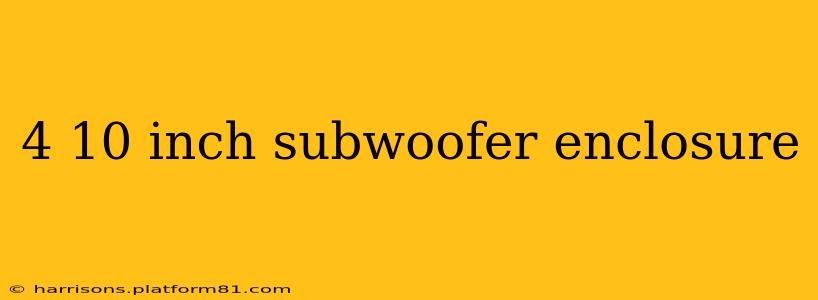Building a subwoofer enclosure for four 10-inch drivers is a significant undertaking, demanding careful planning and execution to achieve optimal performance. This comprehensive guide will delve into the critical aspects of designing, constructing, and optimizing such an enclosure, answering common questions along the way.
What Type of Enclosure is Best for Four 10-Inch Subwoofers?
The ideal enclosure type depends heavily on your desired sound characteristics and the specific 10-inch subwoofer you're using. Several options exist, each with its own advantages and disadvantages:
-
Sealed (Acoustic Suspension): Sealed enclosures are simpler to build, offering tight, controlled bass with good transient response. They generally require less internal volume than ported designs for the same driver. However, they may produce less overall output at the lower frequencies.
-
Ported (Bass Reflex): Ported enclosures utilize a port (tube) to extend the low-frequency response, providing greater output and a more powerful, resonant bass. They are more complex to design, requiring accurate port tuning calculations to avoid unwanted resonances or port chuffing.
-
Bandpass: Bandpass enclosures are more complex and challenging to build, requiring precise calculations and construction. They offer exceptionally high output within a specific frequency range but can be less forgiving of design errors. They're generally not recommended for beginners.
-
Horn: Horn enclosures are highly efficient, offering very high output levels, but they are extremely complex to design and build, demanding specialized woodworking skills and advanced acoustic modeling software. They're usually reserved for professional or very experienced DIY projects.
For four 10-inch subwoofers, a well-designed ported enclosure often delivers the best combination of output and extension, provided you have the space and are comfortable with the added complexity. A carefully calculated sealed enclosure is a solid alternative for a cleaner, tighter sound.
How Much Space Do I Need for Four 10-Inch Subwoofers?
The required enclosure volume depends significantly on the specific subwoofer's specifications (found in the manufacturer's documentation). However, a good starting point for a ported enclosure using four 10-inch subwoofers might be in the range of 6-8 cubic feet total, divided amongst the four subwoofers. This is a rough estimate and should be refined based on your chosen subwoofer's specifications and desired tuning frequency. Using a subwoofer enclosure design software is highly recommended.
A sealed enclosure for four 10-inch subwoofers might require slightly less volume. Again, consult the subwoofer's specifications and use appropriate design software for precise calculations.
What Materials Do I Need to Build a 4x10-Inch Subwoofer Enclosure?
Building a robust enclosure requires high-quality materials:
-
Wood: MDF (Medium-Density Fiberboard) is a popular choice due to its density and stiffness, minimizing unwanted resonances. Birch plywood is another excellent option, offering greater strength but potentially higher cost. Avoid particle board or other low-density materials.
-
Fasteners: Use wood screws appropriate for the chosen wood thickness. Consider countersinking the screws to create a flush surface.
-
Adhesive: Wood glue is essential for strong joints.
-
Sealant: Use an acoustic sealant to seal any gaps or seams to prevent air leaks. This will significantly improve the enclosure's performance.
-
Dampening Material: Adding damping material like polyester fiberfill can help reduce internal resonances and improve the overall sound quality.
How Do I Design a 4x10-Inch Subwoofer Enclosure?
Designing a multi-subwoofer enclosure is best accomplished using specialized subwoofer enclosure design software. These programs allow you to input your subwoofer's Thiele-Small parameters (provided by the manufacturer) and then model different enclosure types and configurations to optimize performance for your specific needs. Accurate modeling is critical, especially for ported enclosures.
Can I Build a 4x10-Inch Subwoofer Enclosure Myself?
Yes, you can! However, building a high-quality, well-performing enclosure requires woodworking skills, careful measurements, and attention to detail. If you lack experience, consider starting with a simpler project before undertaking a four-subwoofer enclosure. Accurate planning and proper execution are crucial for success. Don't underestimate the importance of using design software to avoid costly mistakes.
This guide provides a starting point for your 4x10-inch subwoofer enclosure project. Remember to prioritize accurate calculations, high-quality materials, and meticulous construction for optimal results. Always consult your subwoofer's specifications and utilize design software for the best outcome.
